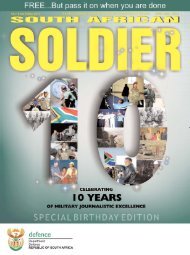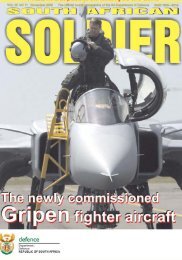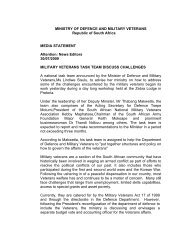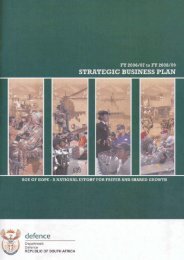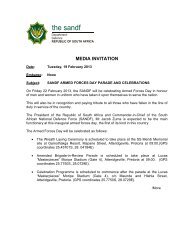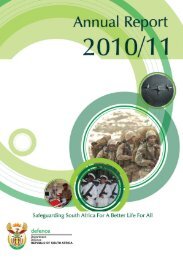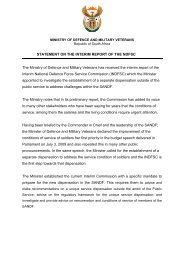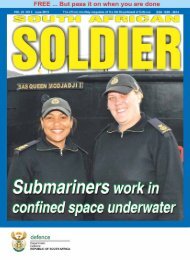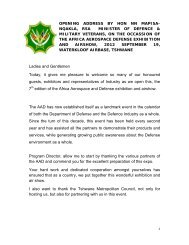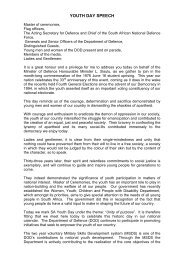Chapter 2 - P rogramme 1 - Department of Defence
Chapter 2 - P rogramme 1 - Department of Defence
Chapter 2 - P rogramme 1 - Department of Defence
You also want an ePaper? Increase the reach of your titles
YUMPU automatically turns print PDFs into web optimized ePapers that Google loves.
| Financial Performance |<br />
Annual Report FY 2007 - 2008 220<br />
| <strong>Department</strong> <strong>of</strong> <strong>Defence</strong> | Vote 20 |<br />
REPORT OF THE ACCOUNTING OFFICER<br />
for the year ended 31 March 2008 (continued)<br />
• Reserves. Significant progress has been made as is evidenced by the increased role played by<br />
Reserves in external and internal deployments. The <strong>Defence</strong> Reserves assisted in supplementing<br />
force levels for peace support operations, and provided the majority <strong>of</strong> the landward conventional<br />
capability. More than 8 700 <strong>of</strong> the 12 264 SA Army Reserves, are from previously disadvantaged<br />
backgrounds. This issue still requires much attention and it is believed that the inflow <strong>of</strong> MSDS<br />
members into the Reserves, once sufficient MSDS members are released from fulltime service, will<br />
greatly alleviate the human resources situation <strong>of</strong> the Reserves. The realisation that the MSDS, in<br />
the interim, will not sufficiently rejuvenate the reserves has led to a decisive intervention to utilise<br />
continued education provision to widen the reserves.<br />
• Education, Training and Development (ETD) Management. An Officers’ Learning<br />
Path (OLP) was developed in accordance with approved career models and was approved for<br />
implementation during the year under review. Learning paths for warrant <strong>of</strong>ficers and noncommissioned<br />
<strong>of</strong>ficers are still under development. The OLP includes the Further Education<br />
and Training Certificate (formative course), Executive National Security P<strong>rogramme</strong> and the Joint<br />
Senior Command and Staff P<strong>rogramme</strong>. SAQA accreditation for the DOD’s learning providers<br />
and learning p<strong>rogramme</strong>s is in process, primarily through the Safety and Security Education and<br />
Training Authority. A sharper focus has been put on improving the p<strong>rogramme</strong> and institutional<br />
accreditation status <strong>of</strong> the DOD learning institutions as well as the pr<strong>of</strong>essional development<br />
p<strong>rogramme</strong>s that have been mobilised during the financial year.<br />
• <strong>Defence</strong> Related Industry. The <strong>Defence</strong>-related Industry Strategy has been completed.<br />
DOD, DTI and DPE will jointly develop and implement the <strong>Defence</strong>-related Industry Strategy.<br />
Further work is continuing to refine the definition, scope and scale <strong>of</strong> strategic capabilities and<br />
the implications there<strong>of</strong> for the defence industry, domestically and globally. The positioning<br />
<strong>of</strong> the DERI to better service the resource and research base <strong>of</strong> the country underscored the<br />
developments in this area during the previous financial year.<br />
1.2 <strong>Defence</strong> Vote: Rm25 922, 255 (Appropriation Act 2007 (Act No 7 <strong>of</strong> 2007)).<br />
1.2.1 The DOD financial year 2007/2008 budget was compiled on a cash basis per p<strong>rogramme</strong> and<br />
amounted to Rm25 922, 255. The approved budget covered the period 1 April 2007 to 31 March<br />
2008 and included all entities under control <strong>of</strong> the Minister <strong>of</strong> <strong>Defence</strong>. The budget was approved<br />
through legislative action and specifically the Appropriation Act, 2007 (Act No 7 <strong>of</strong> 2007). The<br />
budget objectives and policies per main division <strong>of</strong> the Vote were published in the financial year<br />
2007/2008 Strategic Business Plan and the performance against objectives are in detail reported<br />
on in the department’s Annual Report.<br />
1.2.2 The 2007/2008 <strong>Defence</strong> Vote increased by Rm1 256, 479 (5,09%) from the 2006 MTEF allocation<br />
for the same year and increased with Rm2 092, 150 (8,78%) from the allocation <strong>of</strong> the previous<br />
financial year. The <strong>Defence</strong> Vote amounted to 1,27% <strong>of</strong> South Africa’s gross domestic product<br />
(GDP) or 4,78% <strong>of</strong> total government expenditure (GE). These percentages are lower than those<br />
for the financial year 2006/2007 <strong>Defence</strong> Vote, which is an indication that, although the <strong>Defence</strong><br />
Budget is increasing in nominal terms, it does not benefit equally from the country’s economic<br />
growth, both in terms <strong>of</strong> GDP and GE. The year-on-year increase in the overall defence budget<br />
was mainly due to additional allocations appropriated for military skills development, defence<br />
modernisation, defence infrastructure, increase in the remuneration <strong>of</strong> health pr<strong>of</strong>essionals,<br />
foreign exchange rate adjustments on the Strategic <strong>Defence</strong> Procurement P<strong>rogramme</strong> and higher<br />
than average escalation <strong>of</strong> the property management portfolio.



